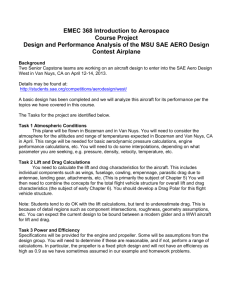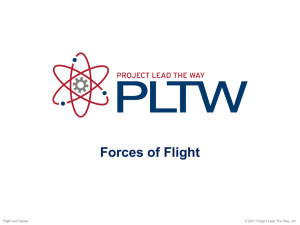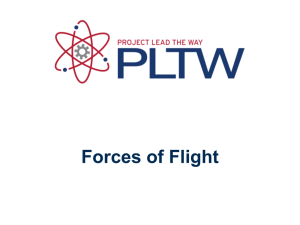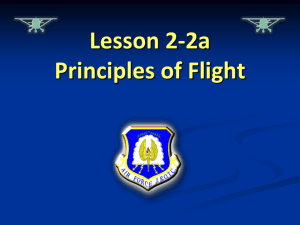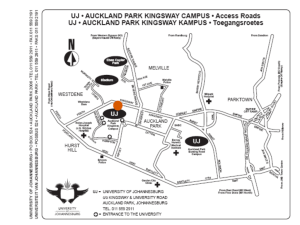Jets in Flight Science Topic: Physics
advertisement
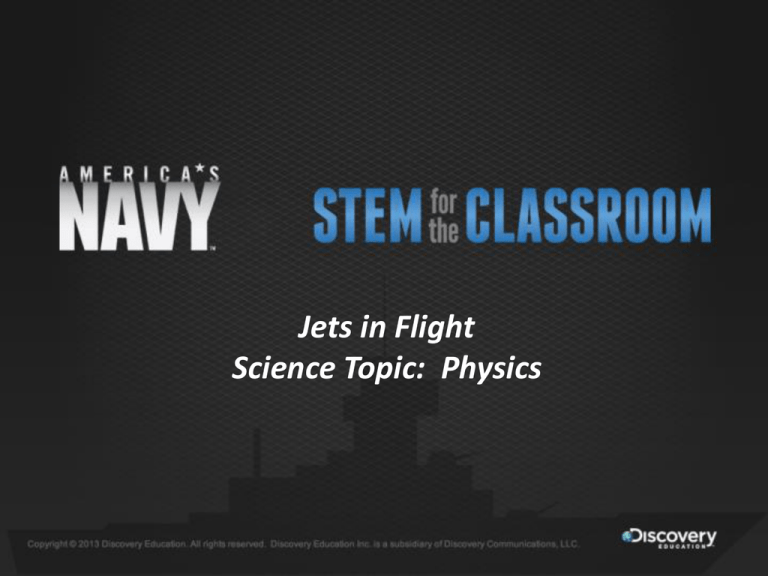
Jets in Flight Science Topic: Physics Lesson Objectives • Understand the Engineering Design Process • Comprehend the basic principles of flight • Apply the Engineering Design Process to aircraft design Navy Aviation Lesson Goal Apply the principles of flight and the engineering design process to design and construct a model of a Navy jet fighter. Lesson Organization • Part 1: Understanding and applying the basic principles of flight • Part 2: Building a working prototype of a Navy jet fighter Vital for Flight Part 1: The Principles of Flight • Forces acting on an aircraft in flight – Thrust: the force that propels an aircraft forward – Drag: air resistance that produces a force in the opposite direction of thrust – Weight: gravitational force – Lift: upward force acting in the opposite direction of weight • Flight is achieved by shifting the balance between the opposing forces • Thrust is produced in one of two ways: – Transfer of momentum when gases are ejected to the rear of the plane through jet engines – Launching a plane with a catapult from the deck of an aircraft carrier Lift is the upward force created as air passes over and beneath the wings of an aircraft • Bernoulli’s Principle: 1. Fast moving air at the top edge of the wing creates a zone of low pressure • Bernoulli’s Principle: 2. Slow moving air along the bottom edge of the wing has the same pressure as the air at the front of the wing (Ambient Pressure) • Bernoulli’s Principle: 3. The difference in pressure creates the force of lift • Lift Momentum: additional upward force is generated incoming air deflects off the bottom of the wing and transfers momentum to the wing Lift Formula • • • • • FL- Force of lift r - Density of air v - Velocity A - Total area of wings Cl – Coefficient of lift Lift Formula • Scenario 1: The total wing area on an F/A-18A is 409 ft2. What is the total lift force exerted on the aircraft while it flies at 1027 ft/s (700 mi/hr) in air of density .00254 sl/ft3 (.0817 lb/ft3) and the lift coefficient of 1.8? Lift Formula • Scenario 2: Suppose the F/A-18C is flying at gross weight 51890 lb (23,537 kg). Given Cl of 1.00, wing area of 409 ft2, and air density of .00254 sl/ft3 (.0817 lb/ft3), at what speed must it fly in order to maintain its level of flight? Resources • http://www.av8n.com/how/htm/4forces.html • http://www.aerotraining.com/reference/AC%206123C_Chapter_1_Canada.pdf • http://www.grc.nasa.gov/WWW/k12/BGA/Sheri/the_lift_equation_act.htm • http://www.fighter-planes.com/info/f18.ht • http://www.grc.nasa.gov/WWW/K-12/airplane/foil2.html Part 2: Designing a Prototype You are an engineer tasked with building a model (prototype) of a small, lightweight aircraft that can carry a small camera (10-25 grams). The Navy plans to use this model in covert operations to collect intelligence. Naval Operations specifications require you to design a catapult to launch the prototype which must fly a minimum horizontal distance of 100 feet while remaining airborne for a minimum of 15 seconds. You may use only approved materials provided by the Navy as described in the Resources List. Maintain a record of your design process in a journal for post-Design assessment. Resources List – – – – – – – – – – – – 1 large foam meat tray per student (unused) 1-2 foam plates per student 1 glue gun per 3 students (with glue sticks) 2-3 bamboo skewers per student 1 roll of scotch tape per 3 students 1 dowel rod per 4 students (cut in halves or quarters) 1 Office Store Rubber Band per student 1 pair of scissors per 2 students (or retractable carpet razors) 1 ruler per 2 students 1 cardboard sealed container per student (ex: Eggo, ½ gallon milk) cleaned. 1 hammer per class Small glob of clay per student Weights: 10 to 25 grams per group Step 1: Identify the Problem • Create a small, lightweight model aircraft that can carry a small camera (10-25 grams) to collect intelligence information for the Navy. Step 2: Identify Criteria and Constraints • • • • Fly at least 100 feet horizontally Maintain flight for at least 15 seconds Construct a catapult device Others? Complete the remaining steps of the engineering design process and demonstrate how your prototype meets the Navy’s specifications.




